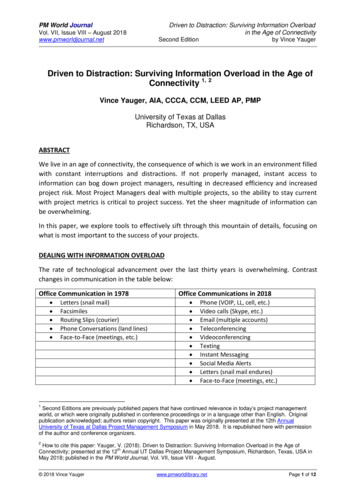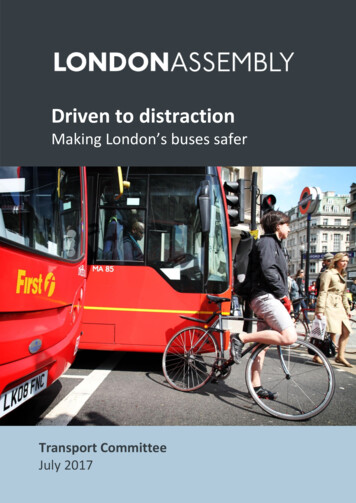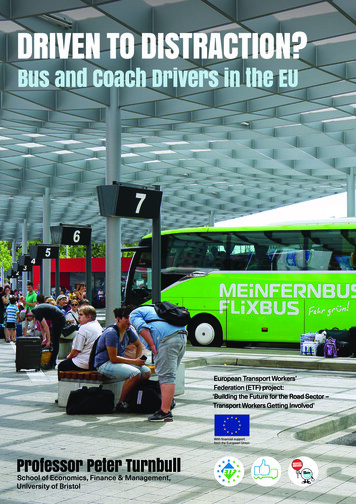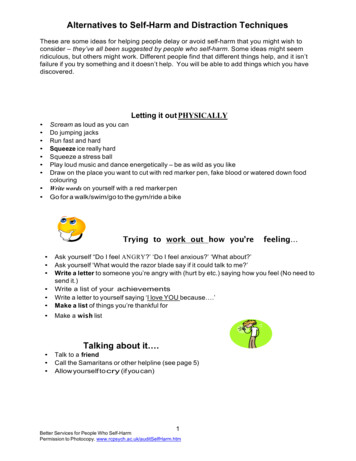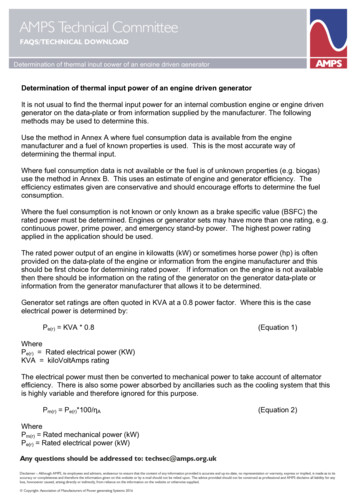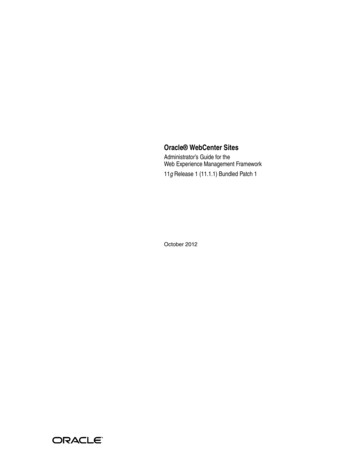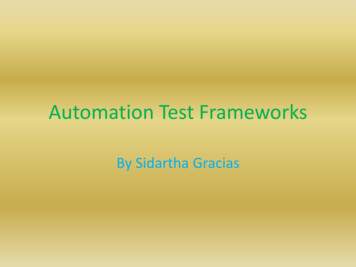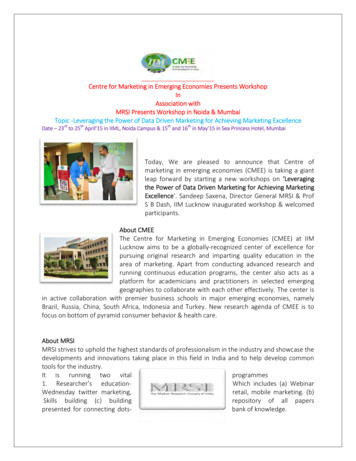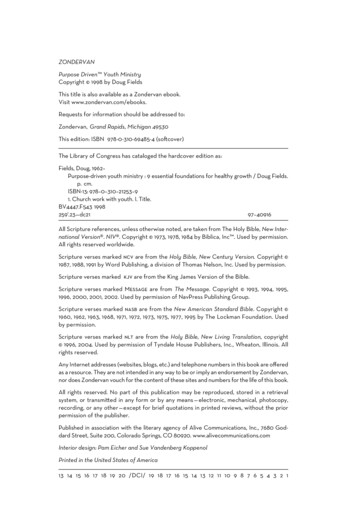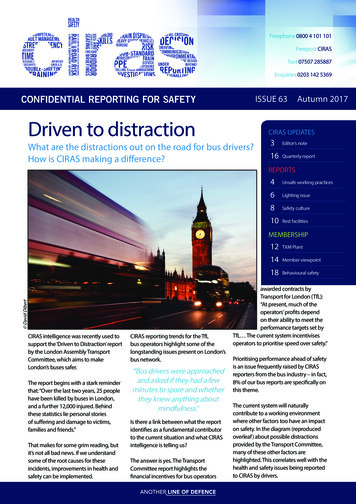
Transcription
Freephone 0800 4 101 101Freepost CIRASText 07507 285887Enquiries 0203 142 5369ISSUE 63Driven to distractionAutumn 2017CIRAS UPDATESWhat are the distractions out on the road for bus drivers?How is CIRAS making a difference?3Editor’s note16Quarterly reportREPORTS4Unsafe working practices6Lighting issue8Safety culture10Rest facilities David DibertMEMBERSHIPCIRAS intelligence was recently used tosupport the ‘Driven to Distraction’ reportby the London Assembly TransportCommittee, which aims to makeLondon’s buses safer.The report begins with a stark reminderthat: “Over the last two years, 25 peoplehave been killed by buses in London,and a further 12,000 injured. Behindthese statistics lie personal storiesof suffering and damage to victims,families and friends.”That makes for some grim reading, butit’s not all bad news. If we understandsome of the root causes for theseincidents, improvements in health andsafety can be implemented.CIRAS reporting trends for the TfLbus operators highlight some of thelongstanding issues present on London’sbus network.“‘Bus drivers were approachedand asked if they had a fewminutes to spare and whetherthey knew anything aboutmindfulness.“Is there a link between what the reportidentifies as a fundamental contributorto the current situation and what CIRASintelligence is telling us?The answer is yes. The TransportCommittee report highlights thefinancial incentives for bus operators12TXM Plant14Member viewpoint18Behavioural safetyawarded contracts byTransport for London (TfL):“At present, much of theoperators’ profits dependon their ability to meet theperformance targets set byTfL The current system incentivisesoperators to prioritise speed over safety.”Prioritising performance ahead of safetyis an issue frequently raised by CIRASreporters from the bus industry – in fact,8% of our bus reports are specifically onthis theme.The current system will naturallycontribute to a working environmentwhere other factors too have an impacton safety. In the diagram (reproducedoverleaf) about possible distractionsprovided by the Transport Committee,many of these other factors arehighlighted. This correlates well with thehealth and safety issues being reportedto CIRAS by drivers.
2CIRASFor example, long shifts and fatigueaccount for 21% of bus reportsto CIRAS. Welfare facilities (oftenconcerning facilities for toilet breaks)account for 12% of CIRAS bus reports.Uncomfortable driver seats account for6%.Bus drivers face a wide range of distractions which may affect their ability todrive a bus safelyIn relation to fatigue, CIRAS has beenhighlighting the safety implications ofan industry wide fatigued workforce formany years.It is good to see the TransportCommittee report acknowledgingour input here: “Chris Langer, SchemeIntelligence Manager at CIRAS, haswritten about the implications of afatigued workforce, and has argued thatfatigue is likely to be under-reportedinternally, in comparison to other healthand safety issues.”Shared learning across transportsectors would bring benefits and TfLis well placed to do this: CIRAS haveobserved that the approach to fatiguemanagement in the rail industry ismirrored by that of the buses.“Confidential reporting provides awindow on the largely hidden worldof fatigued railway staff. Fatigueis often as pervasive as it is underreported. Fortunately, when theytalk confidentially in a blame-freeatmosphere, staff are able to admitto how fatigued they really are.This information is rarely conveyedcompletely honestly through internalreporting channels.”Employers are often unaware of andunderestimate the impact of fatigue ontheir workforce.Source: Transport Committee report ‘Driven to Distraction’. Diagram reproduced with permission.Making a differenceEven before the Transport Committee’sreport, CIRAS had been workinghard not just to highlight the issue ofdistractions on the road, but to helpaddress them with the support of itsmembers.Introducing mindfulness to Abellio busdriversIn collaboration with HSQE ManagerMonica Monti and senior management,six workshops were arranged tointroduce the practice of mindfulness toAbellio bus drivers at their depots.The practice of mindfulness is apowerful tool in this respect.These workshops were held atBattersea, Beddington, Hayes, Southall,Twickenham, and Walworth.Issue 62 of the CIRAS newsletterhighlighted the difference mindfulnesscan make in achieving better driverconcentration, and reducing operationalsafety incidents.Bus drivers were approached and askedif they had a few minutes to spare andwhether they knew anything aboutmindfulness.It could greatly help reduce the numberof bus collisions in London.If they could spare the time and werereceptive, they were then shown a“With the help of CIRAS, we have now delivered several MindfulnessRoadshows at our depots, highlighting the benefits of ‘being in the presentmoment’.“By discussing mindfulness with drivers, we have raised awareness of how easyit is for us all to get distracted and lose concentration when driving, especiallywhen we are stuck in traffic or delayed by roadworks.“By asking drivers to practice mindfulness, we are hoping to reduce thenumber of road traffic collisions whilst increasing happiness and wellbeing onthe road.Watch this space!”Monica Monti, HSQE Manager, Abelliowww.ciras.org.uk
CIRASnine-minute video to explain howmindfulness could benefit their healthand lead to safer driving too.The video focuses on enhancingconcentration by learning to minimisedistractions effectively.The video content described theessence of mindfulness practice withits focus on breathing in the presentmoment, and observing withoutjudgment.The scientifically proven benefits ofpractising mindfulness - such as thereduction in symptoms of stress, anxietyand depression – were also explained.Eating mindfullyThe video content thereafter wasbroken down into seven practical tipsfor everyday mindfulness, before andduring work:1. First drink of the day: paying greaterattention to just noticing sensations2. The morning challenge: bringing themind to the body by checking in withoneself3. Driving awareness: being aware ofone’s surroundings and ready for newhazards4. Stopping at the lights: pausing andfocusing on one’s breathing beforemoving off again5. Eating mindfully: appreciating thetastes, colours, smells and textures offood6. Walking mindfully: avoidingdistractions and paying attention to theact of walking7. Gratitude: appreciating moments andthe positive things one already hasSome drivers had already heard of thepractice of mindfulness, though somehadn’t. Nevertheless, the response wasextremely positive overall.The video content’s usefulness was ratedon average 4.7 out of 5 by drivers.Many drivers expressed a desire to learnmore from the resources suggested.Editor’s noteI feel very honoured to provide theeditorial this time round for theCIRAS newsletter. It’s always been apublication which provides a voice topeople with very genuine health andsafety concerns.I am always conscious that it oftentakes great courage to speak outabout a concern that is botheringyou. Much of the content containedbetween these pages comes directlyfrom you.You have given up your time to reportconscientiously, entrusting us withyour concerns – so thank you! We areseeking new ways of engaging withthe frontline.You will see this coming across in ourstrategy to reach out to more peopleat the coalface.We are not just here to effectivelyfacilitate the resolution of concerns,though that is incredibly importantwork.We are also putting ourselves at theheart of health and safety initiativesto change the way people think andbehave.That’s why we are leading with a storyon a mindfulness initiative within thebus sector with the goal of reducingcollisions.This is all part of getting out there tomeet the people who keep the buses,trains and trams of Britain moving.On our travels, we’re listeningclosely to what you say. Your reportsreally matter to us. Ultimately, theymatter to the whole transportindustry because they can helpdrive substantial health and safetyimprovements.If you believe in reporting like I do,you’ll know there is no such thing as ahealth and safety concern too trivial –they all count.Please don’t just keep it to yourself.Chris LangerScheme Intelligence ManagerIf you’ve tried internal reportingalready, or can’t for some reason, weare here to help make a difference onyour behalf.Health and safety improvements arevery often made as a result of thereports you make confidentially. Andit can be a weight off your mind too.We are also keen to gain yourfeedback on the newsletter – theparts that you enjoy reading, whatyou would like to see more of, andthe things that could be improved.Contact us at: editor@ciras.org.ukSo, I will sign off by saying ‘keepspeaking up, keep reporting!’Freephone 0800 4 101 101 Freepost CIRAS Text 07507 2858873
REPORTUNSAFE WORKING PRACTICESSafety of overhead line work atCrewe improved by Network RailUnsafe working practice changedTHE CONCERN.A reporter raised concerns aboutunsafe working practices in theOverhead Line Condition Renewals(OCR) department at Crewe.“‘.staff felt inhibited aboutreporting their concerns.“The reporter felt they might be downto a culture of cost cutting, whichmay have led to decisions beingmade about equipment and workingpractices which greatly increase therisk of serious injury or even death.The reporter was also concerned thatstaff felt inhibited about reportingtheir concerns, due to a prevailingculture of intimidation.Even where concerns are raised,the reporter felt that any resultingdepartmental investigation coveredup the root causes, leaving the safetyissues unaddressed.The reporter asked ifNetwork Rail could: Get health and safety experts toreview past incidents and anyofficial investigation findings tosee if there is any evidence ofunderreporting. Challenge and review the safetypractices of the OCR department. Question senior management atthe OCR.THE RESPONSE.This was raised several months agoand was originally in reference tothe vehicle acceptance body (VAB)Certificate of Network Rail’s (NR) SRStype Road Rail Vehicles (RRV), stating“No carrying capacity”. Network Rail4Whilst this was confirmed as an errorand only in relation to when in “road”mode (as the vehicles are plant, notlorries), some operatives refusedto load the vehicles (with circa onetonne) in “Rail” mode.This was despite it being normalpractice since their delivery in 1999.Also, all similar vehicles (SRS RRV)nationally do not have this restrictionon their VAB Certificate and carryloads in “Rail” mode.This concern highlighted that manualhandling was difficult once ‘off track’and that climbing into the rear wasalso often needed, which was likelynon-compliant to Working at HeightRegulations.Manual handling was thereforesuspended onto the rear of theNetwork Rail SRS type RRVs until thematter can be addressed.In rail mode, where the height fromground level increases over roadmode, operatives traditionally haveto climb onto the rear of the machinefrom the side ladder to load andunload materials, as they cannot bereached from the ground.Reviews of other sites found thatdeploying trollies (lightweight andheavy) had been successful. It wasalso found that better planning couldremove most of the requirementsto take materials on the rear of themachine floor.“‘.more proactive supportis being encouraged fromsite supervision and safetyrepresentatives.“In parallel, retractions have been putin place on maximum weights thatcan be loaded without mechanicalaids; this has been set at 100kg.www.ciras.org.uk
5REPORTBelow this level, a combinationof mechanical or manual can bedeployed, subject to dynamicassessment and sufficient operatives(e.g. 60kg would usually deploytwo, 25kg would require a singleoperative).During this investigation, it was alsofound that operatives cannot tieoff their harness lanyards and themachines do not have perimetersafety barriers.The assessment therefore establishedthat, whilst manual handling riskwas reduced, it increased working atheight risk.It was also established that someexternal machines (SRS type RRV) hadbeen retrofitted with perimeter safetybarriers. A review of the replacementnew machines (14 No Geismar RRV)due for delivery from late 2017established that lanyard fixing pointsand perimeter safety barriers will beinstalled, thus mitigating this risk.The safety of the operatives iscurrently reliant on their being trainedand experienced at working at height.Whilst there have not been anyaccidents from falls from the RRVmachine floor whilst carrying out thistask, there was agreement that thisdid not comply with the Working atHeight Regulations and operativescould be injured during the task.This was therefore suspended untilbarriers can be erected (proposingretro fit) or the new plant is delivered.NOTE: for emergencies, fitters canstill climb onto the vehicle but mustbe accompanied on the ground by a“warden”.ACTIONS TAKENIt was agreed that the current practicewas no longer acceptable and that,other than for emergencies (e.g.fitter to repair burst hose), climbingon the rear was suspended. For the Network RailThere are still instances of breaches,but this is being challenged andmore proactive support is beingencouraged from site supervision andsafety representatives.exceptions, a “buddying up” schemehas been started.Due to delays in the delivery ofthe Geismar RRVs, the existingSRS vehicles are to be refurbished,including the fitment of perimetersafety barriers. Once in place, theclimbing restriction onto the rear ofthe machine floor will be lifted.The health, safety, quality andenvironmental (HSQE) teaminvestigate all OCR reported accidentsand incidents in line with NRprocedures.Level 1 (L1) reports are completedand forwarded to the national SafetyManagement Intelligence System(SMIS) team. Reconstructions areundertaken for all reported accidents/incidents.The reconstructions involve theinjured person, Trade Union (TU)Safety Reps, supervisor and anyrelevant team member, in orderto produce lessons learnt and toidentify any actions to prevent furtheraccidents/incidents.The outputs are cascaded directly tothe OCR team to discuss during theirweekly safety sessions.Accident/incident data analysis isundertaken each month and theinformation shared via the monthlysafety cascade and monthly businessreview report.Any trends are highlighted andthe information used to focus onthe required safety initiative withinsubsequent periods.OCR has undertaken a programmeof behavioural based safety training,with a focus on site safety and drivingsafely.More recently, certificated trainingin manual handling risk assessmenthas been delivered to managers,supervisors, TU Safety Reps and safetycoaches. Further sessions are plannedin the future.Short-term and long-term solutionsconsidered: Mechanical aids to assist withmoving materials (manual handling) Further safety training initiatives(OCR are part of the National ManualHandling Working Group, WorkActivity Risk Assessment ReviewGroup and Working at Height ReviewGroup). New Plant and Equipment todeliver overhead line equipment(OHL) workbank. Joint NR and TU Safety initiatives,site inspections, project safetystandowns and safety workshops. Continued briefings to the OCRteam that all accidents and incidentsshould be reported. Future manual handling riskassessment course for OCR Staff. Review manual handling riskcontrols.Put it into practice!Ensure that you have beenbriefed on the safe method foryour work tasks and the safetyrequirements for the worksiteon which you are located.Freephone 0800 4 101 101 Freepost CIRAS Text 07507 285887
REPORTEQUIPMENT MAINTENANCESlip, trip and fall risk reduced at fourGWR stationsDefective lighting was replaced and upgradedTHE CONCERN.A reporter is concerned about theinadequacy of station lighting onthe Par to Newquay line. These issueshave been reported a number oftimes, but the slip, trip and fall riskremains unaddressed.A list of the stations affected and thespecific lighting issue follows:Newquay: There are 30 or so lightsinstalled under the canopy, but onlytwo or three work and it is basicallypitch black at night.Quintrell Downs: There are two lightson the platform, one on the accessramp. The platform lights don’t work.Roche: Half the lights aren’t working.Luxulyan: Modern lights havereplaced the old ones, but theyappear to be only half as bright.The reporter asked if GreatWestern Railway could: Investigate the lighting issuesat Newquay, Quintrell Downs,Roche and Luxulyan, and restorethe lighting to full capacity? Investigate whether the lightingat Luxulyan is bright enough forthe station and take appropriateaction?THE RESPONSE.Great Western Raiway (GWR) wouldlike to thank the reporter for raisingthese concerns.Upon receipt of this report, weinformed our facilities team to assistus in investigating the lighting issueson the Newquay branch line, and toprovide a report of the faults raisedand a timescale to ensure compliancein terms of the lights working.“The stations are visitedweekly by the environmentalcleaning team who can reportissues of station failuresincluding lighting.“The report was completed andidentified the following issues: Newquay: the 30 lights installedunder the canopy were checked,and many of them were found to bedefective, resulting in dark conditionsthroughout the station at night.Investigations have revealed that thecanopy lights are not fit for purpose intheir marine environment.Fittings have become badly rustedby exposure to sea air and themaintainer is unable to access thefitting to repair/replace lamps intheir current condition. Job loggedwith operational property help desk(OPHD) for the complete replacementof under canopy lights with marinefriendly aluminium lights. Quintrell Downs: There are twolights on the platform, one on theaccess ramp. The platform lights werefound to not be working at the timeof inspection. Roche: Approximately half theplatform lights were not working atthe time of inspection. Luxulyan: Modern lights havereplaced the old ones and are all inworking order. They are noticeablyless bright but are compliant withminimum lighting level guidance.These lights are currently underwarranty and all operational andmaintenance (O&M) documentationhas been issued to GWR along withappropriate certification and LightingLevel Lux Plots.www.ciras.org.uk GWR6
7REPORTACTIONS TAKENSince undertaking these inspections,Network Rail (NR) has been contactedand confirm it will fund thereplacement light fittings at Newquay.Lighting issues are covered as partof the PGI process with each stationinspected every three months asper our standard. The stations arevisited weekly by the EnvironmentalCleaning Team, which can reportissues liked failed station lighting.Train crew are encouraged to reportdefects when working the branch too.Our contractors are also responsiblefor lighting maintenance, which iscovered within planned maintenance.In addition, a Network RailInfrastructure fault-reporting apphas been launched for smart phones.This will let colleagues log and recordfaults straight away, rather than at theend of their shift. GWRThe works to replace the lights atthis location and repair the lights atQuintrell Downs and Roche beganat the end of January as a matter ofurgency.the introduction of our new trains.As such, this lighting head has gonethrough a vigorous testing regime todemonstrate it complies with thesestandards.The lighting heads were designedto achieve a minimum of 20 lux atthe platform edge and six lux on thevertical, with a maximum spreadbetween lighting columns of 20metres.We hope that the repair andreplacement works alongside ourschedule of regular inspections(which will include out-of-hoursinspections to check lighting), and theencouragement of ad-hoc reportingfrom colleagues will reduce thelikelihood of future lighting issuesalong this line.Lighting column distances vary acrossour stations and, in general, thedistances between them vary from 13metres to 20 metres.“.this lighting head has gonethrough a vigorous testingregime to demonstrateit complies with thesestandards.“Luxluyan Station is classed as a ruralbranch line station and thereforeneeds to comply with “RailwayIndustry Standard Document 7702” byproviding 15 lux at the platform edge.Response following reporterfeedback:The Kirium LED Lighting Head hasbeen designed in partnership withNR & GWR to comply with bothdriver only operation (DOO) and NRlighting standards (Railway IndustryStandard Document 7702 & BS EN12464-2 2007 & 2011) in readiness forThere are some exceptions, but thiswill be resolved as part of NetworkRail’s platform extensions in readinessfor the introduction of our new trains.As part of our testing regime, weused Ascot-Under-Wychwood stationas a “test bed” to prove complianceat 20 metres column spacings, andat Wargrave where the distancebetween columns is 15 metres.As previously described the lightingheads have a built-in movementsensor and, as such, if no movementis detected, they will dim down to20% and when movement is detectedit will increase the lighting level to80% of its capacity and it will remainat this percentage for 20 minutes. Ifno movement is detected within thistime, it will then dim down to 20%.At Luxluyan, the lighting heads wereover 20 years old, inefficient andmaintenance and running costs werehigh.This initiative is a GWR franchisecommitment and it will contributesignificantly to our franchisesustainability targets which are set bythe DTI.It will support GWR’s 14001Environmental ManagementSystem (EMS) to demonstrate ourenvironmental impact is beingmeasured and continuouslyimproved.Furthermore, it will significantlyreduce our electricity charges andreduce our reactive maintenancecosts by three quarters of ouroperational running costs.Put it into practice!Some locations have multiplestakeholders and interfaces.Clarify responsibility with yourline manager for reporting andresponse action at your worklocations.Freephone 0800 4 101 101 Freepost CIRAS Text 07507 285887
8REPORTWORKING ENVIRONMENTControllers reminded on use of‘Flash priority’ messages to driversCloser monitoring leads to the identifying of potential improvementsTHE CONCERN.A reporter has raised a concernabout the communication betweenradio controllers and bus drivers atBattersea Bus Depot.The reporter advised that, currently,any messages sent through to thedriver from a controller appear onthe iBus/mobile data terminal (MDT)screen.“‘.this could lead to a driverbeing distracted whilst the busis in motion.“The reporter says that when amessage comes through, the screenflashes and beeps at the driver.To stop the flashing and beeping onthe screen, the driver must accept,reject or dismiss the message,requiring them to press a buttonlocated behind them.The reporter is concerned that thiscould lead to a driver being distractedwhilst the bus is in motion, potentiallyleading to an accident.In addition, the reporter advises thatdrivers have a minimum of threeminutes after terminating a service toperform safety critical bus checks.These include moving to the standpoint, filling in a log card, changingthe bus service number on the ticketmachine and the front of the bus, andrecording any lost property.The reporter states that when theirservice is late and approaching itsdestination, controllers are calling/messaging the drivers informing themof their planned departure times.The reporter feels that thesedeparture times often require a quickturnaround and do not allow for thechecks at the end of each service.The reporter asked if AbellioLondon could: Review what information isbeing sent to bus drivers andinvestigate if there is a moreopportune time when thesemessages could be delivered? Develop protocols (if alreadynot in existence) providinginformation around theappropriate communication withbus drivers when in motion?www.ciras.org.uk
REPORTTHE RESPONSE.Radio (or iBus) Controllers have twoways to communicate with driverswhilst on the road: voice (through theradio) or by text message.Voice only works when a vehicle isstationary, as the foot switch usedby drivers to talk is on the right-handside of the cab, meaning that theycannot operate the vehicle pedals atthe same time.Text is available in two forms. Thenormal way is that the controllersends a message from the iBus systemwhich is only displayed to the driverwhen the bus is stationary and hasthe front door open.“‘.drivers have a minimumof three minutes afterterminating a service toperform safety critical buschecks.”The other way is through ‘FlashPriority’, which will display themessage on the radio screen as soonas sent and will remain there untilthe driver acknowledges receiptby pressing a button on the in-cabdevice. However, this is not ‘behindthem’ as described in the report, butin front of them.Controllers are advised that the lattermessage should be used minimallyand when the message warrants it(i.e. in an emergency), when the busis on a stand or when the driver is notresponding to radio voice messages.With regards to the ‘turnaround time’referred to, the reporter is correctthat the time allocated is for certaintasks. However, the only time thatthese tasks include conducting asafety check is when the driver hasjust taken over the vehicle. The timescheduled at the end of journeys isa minimum five minutes (althoughthe average is considerably longer),however it can be reduced to threeminutes ‘on the day’ when routes aredisrupted.Details of investigation carried out:We requested a report on ‘Flashpriority’ usage from Transport forLondon (TfL).The data showed that around 15%of all text messages were sent in thisway. Of the 15%, about a half involvedinappropriate use of the ‘Flash priority’facility.We also note that this report wasreceived within a very short time of asimilar issue being raised with depot/team management.Whilst this has not detracted fromus investigating either report, it ispotentially an example of issues thathad been raised locally also beingraised through CIRAS.ACTIONS TAKENControllers have been reminded ofappropriate use of ‘Flash priority’ textmessages.The Controllers’ Managers (ourPerformance Managers) have beentasked with monitoring compliancelive as part of their daily tasks.We have put into place a monthlyrequest to TfL to provide details onthe number of ‘Flash Priority’ textmessages being used. Due to the sizeof the files and pressures on TfL, wewill ask for one route for one day permonth.Where this highlights inappropriateuse, the individuals concerned canbe identified and interviewed tounderstand why they failed to followcorrect procedure.In addition, we have remindeddrivers that they should in turnremind Controllers when they willbe undertaking a safety check if theyhave been given a specific departuretime that would make this difficult forthem to achieve.“‘.monthly request to TfL toprovde details on the numberof ‘flash priority’ text messagesbeing used.”They have also been reminded that,should they not be able to achieve adeparture time given by a Controllerfor any other reasonable reason (suchas having to visit a toilet), they shouldlet the Controller know.Controllers have been reminded thatthey should consider the fact thatdrivers will be undertaking thesechecks if they have just taken the busover when giving departure times.Short-term and long-term solutionsconsidered:A replacement radio system is soonto be developed by TfL. Operatorswill have the opportunity to bringthoughts and ideas on what shouldbe included during the developmentstage. We will ask them to consideralternatives to ‘Flash priority’messages during this process.Put it into practice!Report safety concerns when youobserve them. Early warningscan help prevent incidents.Freephone 0800 4 101 101 Freepost CIRAS Text 07507 2858879
REPORTREST FACILITIESLack of rest facilities promptscollaboration between competitorsAccess to rest facilities providedTHE CONCERN.A reporter is concerned that thereis no meal relief facility or shelterprovided for drivers on the 398 route(which runs from West Ruislip toWood End) at West Ruislip Bus Station.The reporter says the lack of facilitiesmeans that drivers have to eat andrest at fast food restaurants on thehigh street during their meal reliefbreaks.The reporter adds that this may becreating an unsafe and unpleasantwork environment.The reporter asked if RATPDev London could: RATP Dev London10 Provide meal relief facilities andshelter at West Ruislip station,or Provide transport back to NorthHarrow depot to take mealbreaksTHE RESPONSE.We accept that the 398 route providesno meal relief facilities.Those at West Ruislip have 24/7 freeaccess to the railway station’s publictoilets.Additionally, there is easy access toshops and cafes in Ruislip.Whilst this does not answer the issue,there is no contractual requirementfrom Transport for London (TfL) toprovide meal reliefs.TfL inform us that they have no plansto alter the contract for the 398 routethat we run. Operationally, it is notviable to provide extra transportationservices to run drivers back to thegarage in Harrow for meal breaks.The Workplace (Health, Safety andWelfare) Regulations 1992 make itclear that we must provide accessible,suitable and sanitary conveniences;these are available at the railwaystation.The town of Ruislip providesaccessible, suitable and sufficient restand meal facilities within easy walkingdistance (again, in keeping with theprovisions of the WHSWR 1992).ACTIONS TAKEN Discussions were held internally(see above) to debate the optionsavailable in terms of breaks,transport and alternatives. Both the General Manager and BusPriority Manager agreed to talk toanother (larger) bus operator whichalready has facilities for their staff inRuislip. We are currently negotiatingterms of use given that the otheroperator is a direct competitor andalso has routes whic
Driven to distraction CIRAS intelligence was recently used to support the ‘Driven to Distraction’ report by the London Assembly Transport Committee, which aims to make London’s buses safer. The report begins with a stark reminder that: “Over the last two years, 25 people have been
